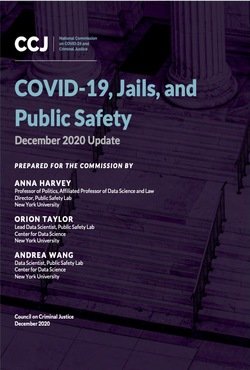By Anna Harvey, Orion Taylor and Andrea Wang
This report, updating the September 2020 Impact Report on COVID-19, Jails, and Public Safety, draws on a sample of approximately 19 million daily individual-level jail records collected by New York University's Public Safety Lab between Jan. 1, 2020 and Oct. 22, 2020. We explore how bookings, releases, and rebooking rates changed during the pandemic, relative to the pre-pandemic period. + Jail populations in the sample decreased by an average of 31% over the six weeks following the March 16 issuance of the White House "Coronavirus Guidelines for America," which expired on April 30. Jail populations then increased and have since recovered half of these decreases, despite explosive COVID-19 case growth in many of the counties in the sample. Counties with higher countywide COVID-19 case growth between March 1 and Oct. 22 have not seen larger reductions in jail populations. The decreases in jail populations after the issuance of the White House Guidelines on March 16, and the lack of responsiveness of jail populations to local COVID prevalence after those guidelines expired, suggest the importance of clear policy directives for reducing disease transmission risk within county jails. + Jail bookings dropped sharply in mid-March and remain on average 36% below pre-pandemic levels. As bookings declined, the characteristics of those booked into jails shifted. Those booked into jails between mid-March and late October were booked on more charges on average, were more likely to be booked on felony charges, and were less likely to be booked on lesser charges like…..
-
failure to appear, than those booked into jails prior to this period. + Although jail bookings dropped after mid-March, those booked into jails were detained for longer periods of time. Average detention duration increased sharply after mid-March, doubling from about 15 to 30 days, and remains nearly twice as high as the pre-pandemic average detention duration. This increase has offset reductions in admissions, and contributed to rebounding jail populations observed since mid-March. + Parallel to trends in daily bookings, daily releases dropped sharply in mid-March and remain approximately 40% below baseline levels. Those released from jails between mid-March and late October had been booked on more charges on average, were more likely to have been booked on felony charges, and were less likely to have been booked on lesser charges such as failure to appear, than those released from jails prior to mid-March. The rate at which those released from detention are rebooked into jail following release is one possible measure of the public safety risk of jail releases. To date, 30-, 60-, 90-, and 180-day rebooking rates among those released during the pandemic have remained 13% - 33% below pre-pandemic rebooking rates. To the extent that rebooking rates measure the average public safety risk of releasing individuals from jail, this risk remains lower now than prior to the pandemic. + While the proportion of Black individuals among daily jail admissions did not change appreciably during the pandemic, the proportion of Black people among those released from jails during the pandemic decreased by approximately 5% relative to the pre-pandemic period. As a result, the proportion of jail populations composed of Black individuals rose during the pandemic.
Washington, D.C.: Council on Criminal Justice, December 2020. 27p.


